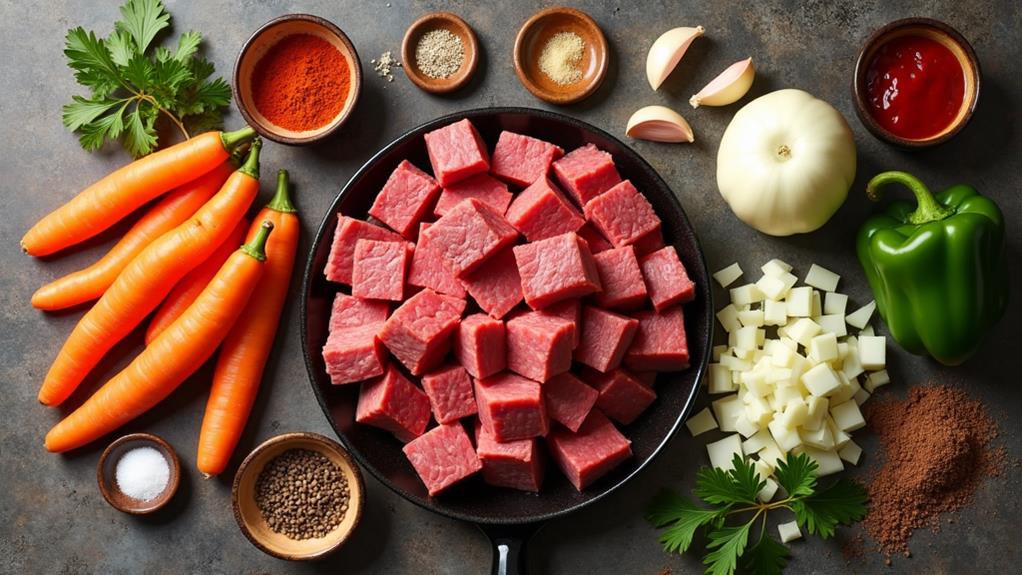When you think of a dish that wraps you in a warm blanket on a chilly evening, beef goulash often comes to mind. This classic Eastern European comfort food offers a delightful blend of flavors and textures, but its history is just as rich as its taste. You might wonder how this humble stew evolved into a beloved staple across various cultures. The secret lies not only in the ingredients but also in the cooking techniques that have been passed down through generations. What's the story behind your favorite goulash recipe?
Key Takeaways
- Beef goulash is a comforting Eastern European dish made with tender beef, sweet paprika, and vegetables in a rich sauce.
- Traditional goulash simmers for 2 to 2.5 hours, developing deep flavors; a pressure cooker can reduce this time.
- Serve beef goulash with egg noodles, crusty bread, or creamy mashed potatoes to enhance the meal experience.
- This dish is flexible, allowing for spice adjustments, and leftovers freeze well for future meals.
- Goulash represents a shared culinary heritage, ideal for family gatherings and cozy dinners with loved ones.
History
Goulash's rich history reflects the culinary traditions of Hungarian herdsmen, as its name "gulyás" translates to "herdsman" or "cowboy." Originating in Hungary, this hearty dish traditionally combines beef, paprika, and vegetables, evolving into various regional versions throughout Eastern Europe.
You'll find that Hungarian goulash stands out for its thick, stew-like consistency, heavily seasoned with paprika, a spice that's essential to Hungarian culture and cuisine.
As goulash traveled beyond Hungary, it gained popularity in the United States during the 19th century. Here, it morphed into a simpler version known as American Goulash, featuring ground beef and macaroni. This adaptation reflects the American love for comfort food, making it a staple at potlucks and family gatherings.
Goulash isn't just a dish; it's a taste of shared culinary heritage that brings people together, reminding you of cozy dinners with loved ones.
With its deep roots and evolving recipes, goulash continues to inspire creativity in kitchens. So, whether you're savoring a traditional Hungarian goulash or a quick American version, you're partaking in a delicious history that transcends borders and generations.
Recipe

Beef Goulash is a hearty and flavorful dish that embodies the essence of Eastern European comfort food. Originating from Hungary, this dish is characterized by its rich sauce and tender beef, making it perfect for family gatherings or a cozy dinner at home. The slow-cooked beef, combined with aromatic vegetables and spices, creates a savory experience that warms the soul.
It's an easy dish to prepare, requiring minimal active cooking time but allowing for a long simmer to develop deep flavors.
To begin your Beef Goulash, choose a good quality chuck roast that will become tender during the slow cooking process. The key to a great goulash lies in the balance of sweet Hungarian paprika and the aromatic vegetables like onions and garlic. Serve this delightful dish over egg noodles or creamy mashed potatoes for a complete meal, and don't forget to garnish with fresh parsley and a dollop of sour cream for added richness.
Ingredients:
- 2 pounds chuck roast, cut into 1-inch cubes
- 2 tablespoons olive oil
- 2 large onions, diced
- 3 cloves garlic, minced
- 2 tablespoons sweet Hungarian paprika
- 1 teaspoon caraway seeds
- 1 teaspoon salt
- 1/2 teaspoon black pepper
- 4 cups beef stock
- 2 carrots, sliced
- 2 bell peppers, diced
- 2 tablespoons tomato paste
- Fresh parsley, chopped (for garnish)
- Sour cream (for serving)
- Egg noodles or mashed potatoes (for serving)
To cook the goulash, heat the olive oil in a large pot or Dutch oven over medium-high heat. Add the cubed beef and brown on all sides, then remove and set aside.
In the same pot, add the diced onions and cook until softened, about 5 minutes. Stir in the minced garlic, paprika, caraway seeds, salt, and black pepper, cooking for another minute until fragrant.
Return the beef to the pot, then add the beef stock, sliced carrots, diced bell peppers, and tomato paste. Bring the mixture to a boil, then reduce the heat to low, cover, and let it simmer for 2 to 2.5 hours until the beef is tender and the flavors have melded together.
When preparing Beef Goulash, remember that the longer you let it simmer, the better the flavors will develop. If you're short on time, you can use a pressure cooker to reduce the cooking time considerably, but traditional slow cooking will yield the best results.
Additionally, you can adjust the spices according to your taste; for a little heat, consider adding a pinch of cayenne pepper or some diced jalapeños. If you have leftovers, they freeze well, allowing you to enjoy this comforting dish even on busy days.
Similar dishes that feature tender meat and rich sauces include Hungarian Pörkölt, which is often considered a meat stew, and various beef stews from different cultures, such as Irish Beef Stew or French Beef Bourguignon, all highlighting the joy of slow-cooked flavors.
Final Notes
When preparing Beef Goulash, it's important to remember that this dish shines with its deep, rich flavors. This traditional Hungarian goulash is all about tender beef, paprika, and a mix of hearty vegetables simmered together for comfort on a chilly evening.
The key to a truly satisfying meal lies in the cooking time; aim for about 2 to 2.5 hours to achieve that melt-in-your-mouth tenderness.
When serving your beef goulash, think beyond the bowl! You can elevate the experience by pairing it with crusty bread, egg noodles, or even homemade dumplings. Each option brings its own unique twist, enhancing the rich flavors of the goulash.
Picture dipping that crusty bread into the savory sauce or twirling egg noodles around your fork, soaking up every delicious drop.
Don't forget, this dish packs a nutritional punch, making it a perfect choice for family gatherings or cozy nights in.
